
- Index
- Age
- Antique
- Brand
- 1847 Rogers Bros (39)
- Barker Ellis (27)
- Birmingham (55)
- Christofle (159)
- Christopher Dresser (19)
- Community (21)
- Gorham (90)
- International Silver (81)
- Mappin & Webb (16)
- Meriden Britannia (34)
- Oneida (48)
- Poole (23)
- Reed & Barton (243)
- Sheffield (148)
- Sheridan (40)
- Towle (30)
- Unknown (21)
- Wallace (148)
- Wm. Rogers & Son (22)
- Wmf (32)
- ... (2220)
- Composition
- Pattern
- Style
- Aesthetic (11)
- American Empire (8)
- Antique (38)
- Art Deco (278)
- Art Nouveau (126)
- Baroque (90)
- Baroque & Rococo (30)
- Chippendale (9)
- Classic (8)
- Edwardian (46)
- Empire (16)
- Georgian (47)
- Gold Plate (7)
- Louis Xv (22)
- Mid-century Modern (49)
- Neoclassical (9)
- Queen Anne (8)
- Rococo (9)
- Victorian (547)
- Vintage (11)
- ... (2147)
ANTIQUE 19thC VICTORIAN RARE SILVER PLATE MOUNTED COCO-DE-MER TEA CADDY c. 1880
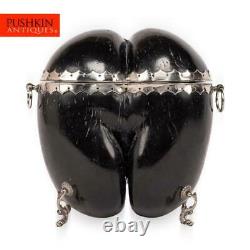
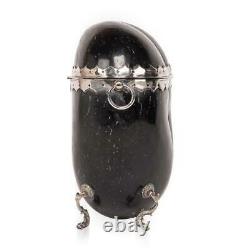
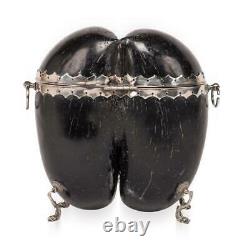
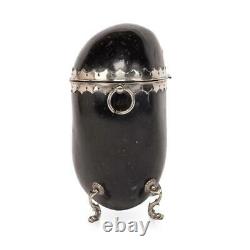
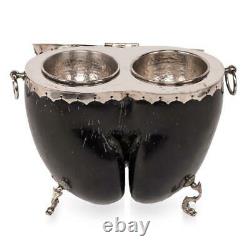
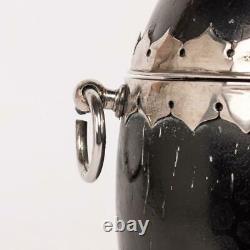
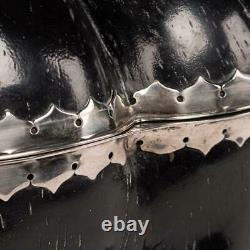

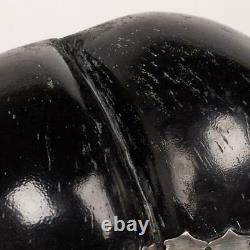
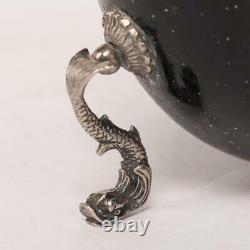
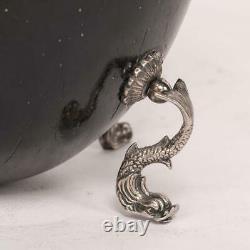


Antique 19th Century Victorian rare tea caddy fashioned from a coco de mer nut with silver plated mounts. The nut itself derived from the Seychelles in the late 19th century and the silver plated mounts applied to it by a skilled silversmith in England around the same period with its intricately detailed dolphin feet recalling its seafaring background harking back to the time of Colonial trade routes to the far east. ANTIQUE 19thC VICTORIAN RARE SILVER PLATE MOUNTED COCO-DE-MER TEA CADDY c. Formerly known as Maldive coconut, its scientific name, Lodoicea maldivica, originated before the 18th century when the Seychelles were uninhabited.
In centuries past the coconuts that fell from the trees and ended up in the sea would be carried away eastwards by the prevailing sea currents. The nuts can only float after the germination process, when they are hollow. In this way many drifted to the Maldives where they were gathered from the beaches and valued as an important trade and medicinal item. This association is reflected in one of the plant's archaic botanical names, Lodoicea callipyge in which callipyge is from Greek words meaning'beautiful buttocks'. Until the true source of the nut was discovered in 1768 by Dufresne, it was believed by many to grow on a mythical tree at the bottom of the sea.
European nobles in the sixteenth century would often have the shells of these nuts polished and decorated with valuable jewels as collectibles for their private galleries. The coco de mer tree is now a rare and protected species. In Great Condition - N. Cm Width: 30 x 15cm.
All items are cleaned and inspected before being dispatched, we use only the best packing materials to insure your item reaches you safely and discreetly. Get images that make Supersized seem small. Showcase your items with Auctiva's. The item "ANTIQUE 19thC VICTORIAN RARE SILVER PLATE MOUNTED COCO-DE-MER TEA CADDY c. 1880" is in sale since Friday, March 5, 2021.This item is in the category "Antiques\Asian/Oriental Antiques\Indian".antiques" and is located in London.
This item can be shipped worldwide.
- Product: Holy water container
- Primary Material: coco-de-mer & solid silver
- Age: 1850-1899
- Region of Origin: Indian
- Original/Repro: Original

